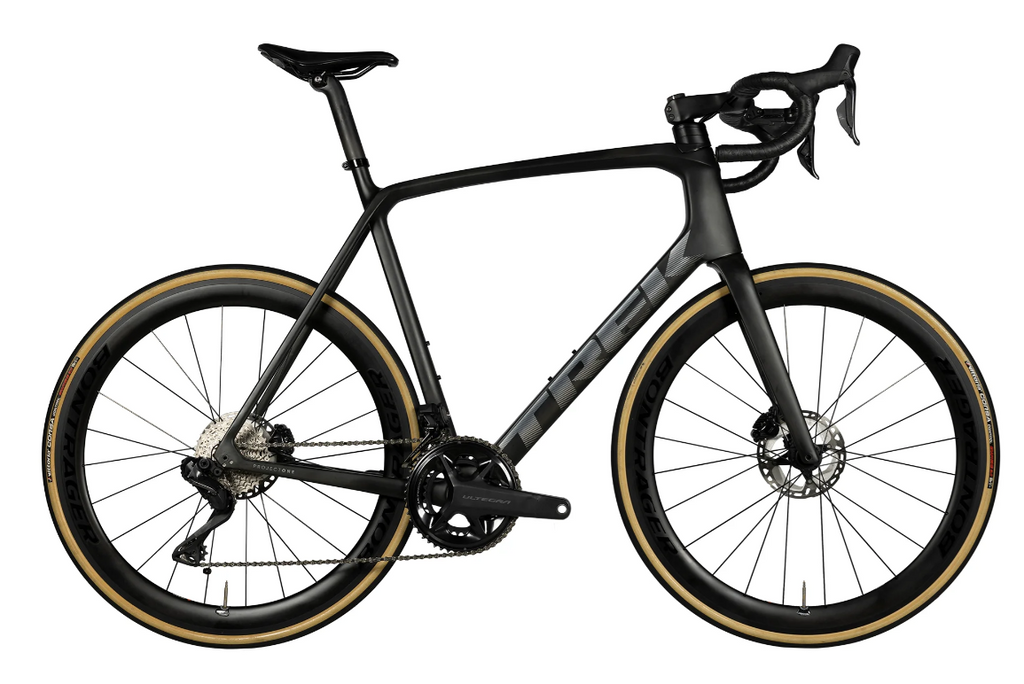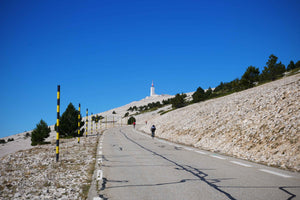Mont Ventoux by Bike : how do you prepare?
In this Article
Published on 25th April 2024
The ascent of Mont Ventoux by bike is both legendary and daunting. Considered one of France's most demanding climbs, it poses a challenge for both novice cyclists and the most experienced. Between its reputation as a tough climb, its changing climate, and its dramatic summit, Mont Ventoux, with its 20.8 kilometres in length and 1,594 metres of elevation gain, leaves no one indifferent. What training methods are recommended to prepare for tackling its relentless slopes? How can you manage your effort effectively during this demanding climb? Here's how to prepare properly to climb Mont Ventoux by bike.

Having Appropriate Training to Climb Mont Ventoux
Before embarking on the ascent of Mont Ventoux by bike, it's crucial to understand that this challenge is accessible to all levels. However, given the difficulty and duration of this epic climb, adequate preparation is highly recommended to fully enjoy it.
Regarding training, it's essential to develop your aerobic endurance capacity to be ready to tackle this long ride, which can easily exceed 4 hours in the saddle. To do this, focus on developing your aerobic base by regularly doing moderate-intensity sessions. Training in real conditions, on hilly or mountainous routes, is particularly beneficial for improving your climbing technique. Indeed, during long ascents, the muscles of the lower back and upper muscle chains are more solicited than during efforts on flat terrain.
It is therefore crucial to develop good overall endurance. This requires covering at least 1,000 kilometres by bike, with two to three rides of 3 hours per week. An effective strategy is to train on other summits of similar size to familiarise yourself with the challenges of such a climb.
Use a Turbo Trainer
If you have a connected turbo trainer, you can also virtually test yourself on Zwift before your actual ascent. Indeed, Zwift offers an almost perfect replica of Mont Ventoux called "Ven-Top". Although the experience is different from reality, it will allow you to identify critical points and strengthen your mental determination on D-day.

Climbing Mont Ventoux by Bike, Yes, but Well Equipped
Having Appropriate Cycling Attire
When planning a ride at altitude, it's essential to consider the specific weather conditions of Mont Ventoux. Located in the south of France, this summit is often the scene of very hot or extremely windy days, which can significantly complicate your ascent. Indeed, beyond making your climb difficult, these conditions can even make it dangerous. It's not uncommon to encounter gusts of wind exceeding 100 km/h at the summit of Mont Ventoux. Therefore, it's essential to monitor altitude weather forecasts carefully and possibly postpone your ascent if conditions are too extreme. In summer, it's advisable to choose an early morning or late afternoon departure to reach Mont Ventoux before the peak heat that usually occurs from noon onwards.
It's also crucial to adapt your equipment to the weather conditions. In mid-season, leg warmers or arm warmers can be useful to protect your limbs as soon as you reach the summit, thus preventing you from getting cold and allowing you to descend in optimal comfort conditions.
Choose the Right Gear Ratio
For a smooth ascent and effective effort management, the choice of gear ratio is crucial when climbing Mont Ventoux by bike. Although some cyclists can maintain a rhythm with a low cadence of about 60 revolutions per minute in the mountains, it's generally recommended to adopt a higher velocity for optimal pedalling efficiency and muscle fibre economy.
Having a sufficient development allows you to preserve your energy to tackle the steepest sections of the climb. The minimum recommended gear ratio for climbing Mont Ventoux is 36 x 28, but this option is reserved for the most trained cyclists. For most athletes, combinations like 36 x 32 or 34 x 32 will be much more suitable for reaching the summit, offering a comfortable margin to tackle the steepest slopes.
If you're a mountain novice with little experience, it's best to prioritize safety by opting, where possible, for a gear ratio of 34 x 34. This is one of the maximum gear combinations available on a road bike. Make sure, however, that the length of your rear derailleur is sufficient to accommodate such a development.
Having an Adapted Road Bike
Ideally, you should have a good climbing bike. That is to say, a lightweight road bike offering increased road holding precision compared to endurance bikes and able to compete with aero bikes in terms of agility. This type of bike reduces road vibrations and improves riding comfort. It offers a compromise between comfort and stiffness. The lightweight road bike is more comfortable than the aero bike while being stiffer than the endurance bike.
👉What's the best bike for climbing? The Cyclist House selection.

Plan Your Route for the Ascent of the Giant of Provence
Dominating the Provencal plain with its 1,910 meters altitude, Mont Ventoux, also known as the "Bald Mountain" for its barren summit, remains an iconic challenge for cyclists. Its particularity lies in its three distinct slopes, each with its own characteristics.
Profile of the Ascent of Mont Ventoux by Bike from Bédoin
The most famous, but also the most demanding, slope starts from the village of Bédoin. This epic climb stretches over 21 kilometres, with an average gradient of 7.5%, offering a total elevation gain of 1,590 metres. The time required to reach the summit generally varies between 1 hour 30 minutes for the most seasoned cyclists and 2 hours 30 minutes for intermediate level riders. The difficulty lies in the constant road incline, starting from the Saint Estève turn, after a gentle introduction from Bédoin (4 kilometres at a gradient of 4 to 5%). The most feared section is probably the 10-kilometre stretch at 9.5% gradient, mainly straight. After leaving the forest at the legendary Chalet Reynard level, there are still 6 kilometres to go, with a gradient oscillating between 7 and 9%. The summit, bare and exposed to the winds, requires special attention, especially regarding weather conditions.

Ascent from Malaucène
The other two slopes of Mont Ventoux, from Sault or Malaucène, offer similar yet different challenges. The west slope, from Malaucène, offers 21 kilometres at an average gradient of 7%, with sections reaching up to 13% and others gentler around 2 to 3%. A welcome respite is offered in portions where the gradient decreases to around 5%, allowing cyclists to catch their breath and refuel.
Clime of the Pass from Sault
Finally, the east slope, from Sault, presents the most accessible option for climbing Mont Ventoux by bike. Although longer (25.7 kilometres), this slope offers an average gradient not exceeding 4.5%. With a starting point at an altitude of 760 meters, the total ascent is less arduous compared to the other slopes. The trickiest sections are between kilometres 3 and 12, as well as the last 6 kilometres (shared with the ascent from Bédoin, from Chalet Reynard where the two roads converge). The rest of the route is relatively smooth, with average gradients below 3%. This ascent from Sault is therefore recommended for beginners wishing to avoid the frontal challenges of the Bédoin or Malaucène slopes.
Eat and Hydrate Properly
When venturing on the roads of Mont Ventoux, hunger and energy drops are not uncommon. Knowing how to assess your physical capabilities is one thing, but knowing how to manage your effort and adequately nourish your body is another. Adequate hydration and nutrition are the cornerstones of any sports performance, especially endurance sports like cycling.
During the effort, it's recommended to drink about 500 ml of water or sports drink per hour, or even more in hot weather. Dehydration can occur quickly, given the duration of the climb, and it can seriously hinder the challenge.
It's better to drink regularly in small quantities, like two sips every 10 minutes. Since the body loses a lot of minerals through sweating, it's crucial to compensate for these losses with sodium. Water containing sodium and sugar is better absorbed and utilized by the body than plain water.
Regarding nutrition, the same principles apply: eating regularly in small quantities allows the body to efficiently assimilate ingested carbohydrates, providing a constant supply of energy. Like dehydration, hypoglycemia can lead to a slowdown or even a complete stop of the effort, so it's essential to be methodical and regular in your food intake.
Manage Your Effort
Finding your rhythm and avoiding starting too hard is essential to succeed in an ascent like that of Mont Ventoux. From the start, it's crucial to manage your gearing well to adopt a comfortable and sustainable pedaling cadence. You should feel some breathlessness, but not be in excessive muscular pain. If you find yourself riding at a speed that puts you in the red, reduce the intensity and opt for a more moderate pace, between 10 and 12 km/h. It's essential to find the right gearing, while keeping some leeway on your gearing in case the climb becomes more difficult. By adopting a smooth pedaling technique, you'll save your muscular strength and thus prolong your effort.
It's advisable to stay seated for as long as possible during the ascent. This position preserves your energy and allows you to catch your breath. Standing up from time to time for 10 to 15 seconds can be beneficial to stretch your muscles and relieve your lower back, but it shouldn't become the norm, as it can lead to an increase in your heart rate.
The key is to find your own rhythm. Even if you're climbing with other cyclists, it's important not to let yourself be influenced by their cadence. Everyone has their own level and limits. On Mont Ventoux, the race is primarily against yourself. It's possible to find a training partner to motivate and support you, but it's essential to focus on your own performance and listen to your body throughout the ascent.
Prefer to climb Mont Ventoux on an electric road bike? Discover our range of reconditioned electric road bikes to help you climb the most beautiful passes in France.





























1 comment
This is a really useful no nonsense and informative article. I intend to cycle up Ventoux this summer and found this article really encouraging! Thank you.